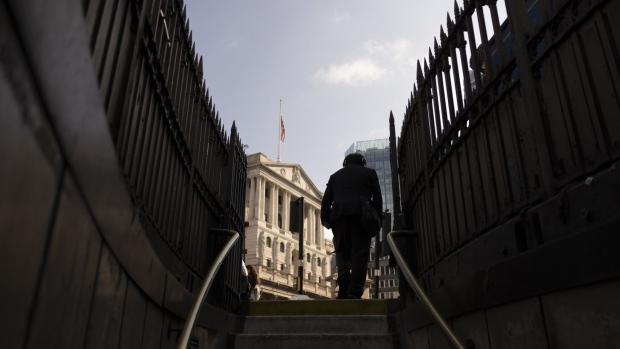Jun 22, 2023
Pound Falls, Gilts Mixed After BOE Accelerates Rate-Hike Drive
, Bloomberg News

(Bloomberg) -- Higher interest rates alone may no longer be enough to sustain the pound’s rally.
For the second day in a row, the prospect of rising rates failed to prop up the currency. Instead, the dawning realization that borrowing costs are bound to inflict damage on households and companies whipsawed the pound and prompted comparisons with emerging markets.
Sterling is this year’s best-performing currency, bolstered by a policy rate that now towers over the ECB’s own and even rivals the Fed’s. Expectations are that the Bank of England will drive it to as high as 6% — the most in more than two decades — to tame inflation.
But that tailwind is now turning into a clear drag, with UBP saying Thursday’s 50 basis point increase smacks of “panic” and Jupiter Asset Management calling it tacit admission by BOE officials that they’re well behind the curve.
“The Bank of England needs to face up to the fact that the UK is drifting aimlessly into emerging market territory,” said Muhammed Demir, head of capital markets at Swiss Finance Corporation. “If there are no structural improvements to the UK economy, we will continue to see rates rising, inflation sticky and anemic economic growth. This will inevitably lead to a weaker pound in the long run.”
The surprise acceleration of the BOE’s tightening drive sent the pound on a jarring ride Thursday. Initially sterling spiked higher, but within minutes the move had reversed. UK bonds were mixed, with shorter-maturity yields rising while longer-tenor rates fell on the growth concerns.
Typically, higher interest rates bolster a currency by burnishing its so called carry-trade appeal. Investors borrow in currencies where interest rates are low and use the cash to buy assets in countries where rates, and potential returns, are higher.
But sterling was trading little changed at $1.2755 as of 1:44 p.m. in London, erasing gains of as much as 0.5% and a drop of 0.3% earlier.
The moves echoed the pound’s drop one day earlier, when fresh data showed consumer prices held at 8.7% in May, the fourth consecutive month of faster-than-expected numbers. That triggered a fresh wave of bets against sterling in the options market, with so-called risk reversals pointing to the most bearish positioning and sentiment in almost five months versus the euro.
UK Stagflation Fears Add to Pound’s Woes Despite Higher Rates
Policy makers led by Governor Andrew Bailey reiterated earlier guidance pointing toward higher rates, doing nothing to rein in market expectations for the peak.
For borrowers, the move signals further hardship. Two year mortgage rates have tripled to more than 6% since March 2022, and experts are warning of a mortgage “time bomb” as households refinance at unaffordable levels.
The repricing Thursday further inverted the UK yield curve, suggesting the market is more concerned over the growth outlook and expects rates to fall well into the future. The 10-year yield is now more than 70 basis points below its two-year peer, the most since the turn of the century.
“This ironically will see pound weakness,” said Jordan Rochester, FX strategist at Nomura. “I suspected kneejerk pound strength on the 50 basis points at first, but ultimately this could lower the odds of more hikes needed later this year, and with it see pound strength limited given just how much was already priced in before this.”
(Updates throughout)
©2023 Bloomberg L.P.






